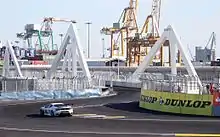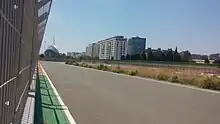 | |
| Location | Valencia, Spain |
|---|---|
| Time zone | CET (UTC+1) CEST (DST) |
| Coordinates | 39°27′31.6″N 0°19′32″W / 39.458778°N 0.32556°W |
| Opened | July 2008 |
| Closed | 2013 |
| Architect | Hermann Tilke |
| Major events | Formula One European Grand Prix (2008–2012) GP2 (2008–2012) GP3 (2010–2012) Porsche Supercup (2008–2010, 2012) Formula BMW Europe (2008–2010) International GT Open (2008) Spanish F3 (2008) |
| Website | http://www.valenciastreetcircuit.com/index_eng.html |
| Grand Prix Circuit (2008–2012) | |
| Surface | Asphalt |
| Length | 5.419 km (3.367 miles) |
| Turns | 25 |
| Race lap record | 1:38.683 ( |

The Valencia Street Circuit (Valencian: Circuit Urbà de València, Spanish: Circuito Urbano de Valencia) was a street circuit in Valencia, Spain which hosted the Formula One European Grand Prix for five years (2008–2012).[1][2] The first race meeting on the circuit was held over the 23/24 August 2008 weekend,[3] with Felipe Massa winning the main event, the European Grand Prix, after starting from pole position. The circuit used the roads skirting the city's harbour and America's Cup port area[4] – including a section over a 140-metre-long (460 ft) swing bridge[5] – and also included some roads designed exclusively for racing purposes by the German architect Hermann Tilke, who also designed the infrastructure buildings for the circuit. The 2012 edition took place on 24 June[6][7] and was the last to go under the name of the European Grand Prix until 2016, when the Baku City Circuit used the title for one year. The circuit has been left abandoned after a deal fell through to alternate this venue with Catalunya in Barcelona to host the Spanish Grand Prix.[8]
History

The deal to host the Valencia race was signed on 1 June 2007, and was for seven years.[9] The deal was made between Formula One supremo Bernie Ecclestone and the Valmor Sport group, led by former motorcycle racer Jorge "Aspar" Martínez and Villarreal CF's president Fernando Roig. The deal came about despite Ecclestone previously stating that no European country should hold more than one race each year, as there was already a Spanish Grand Prix at the Circuit de Catalunya.
Initially, the deal was rumoured to be conditional on the People's Party winning regional elections on 27 May 2007.[10] On 16 May, Ecclestone clarified his comments, explaining "I said I wouldn't formalise a contract until after the elections because I didn't know who I would be signing it with" and claiming his earlier statements had been taken out of context.[11] Ecclestone was later cleared of influencing the election by the Valencian Electoral Commission.[12]
The official track layout was unveiled by Valencia Councillor and transport counselor, Mario Flores, on 19 July 2007. The track was first used in the last weekend of July 2008, as the circuit hosted a round of the Spanish F3 Championship and International GT Open. It was first used for the European Grand Prix on 24 August 2008.
Layout
The track was 5.419 km (3.367 mi) long and incorporated a total of 25 turns – 11 left-handers and 14 right-handers.[13][14] It was estimated that the track had a top speed of around 323 km/h (201 mph),[13] with a lap record of 1:38.683, set by Timo Glock during the 2009 European Grand Prix. Valencia was not as tight as Circuit de Monaco but overtaking opportunities were still scarce, due to the straights not being straight and the dust away from the racing line. Nico Hülkenberg noted there was quite a lot of space for a street circuit, and some corners had a lot of run-off area; Robert Kubica suggested that good traction and braking stability were crucial to win at the circuit, due to the number of long straights that ended in heavy braking zones.[4]

The circuit was criticised by drivers for its lack of overtaking opportunities. Changes in Formula One in 2011, including the introduction of the Drag Reduction System and the switch to Pirelli tyres, partially improved that with 27 passes recorded in that year's race, 22 of which were accredited to the assistance of DRS.[15] However, the five 'normal' overtakes still represented the year's second lowest total, although the adoption of two DRS zones for that year's race limited the potential for non-DRS assisted passes. Despite this, the 2012 race was shown to have many different overtakes and became one of the most thrilling races of the season.[16][17] It also had four retirements compared to zero during the 2011 race.
A lap in a Formula One car
The pit straight is short and immediately leads into the flat-out turn 1 before cars heavily brake down to 97 km/h (60 mph) for the right-left complex of turns 2 and 3, passing the Grau Metro station.[18] A curved 'straight' leads into a left-right chicane: turns 4 and 5, by the Neptune Hotel. Drivers exit the 137 km/h (85 mph) chicane by running very close to the wall, before sweeping through the kinks of turns 6 and 7, then braking heavily for the following swing bridge section. One of the slowest corners on the track, turn 8, with an apex speed of around 89 km/h (55 mph), leads drivers over the bridge before immediately braking again into the equally slow turn 10.[19] Good traction is important out of here as the following section is a DRS zone with a top speed along the kinked 'straight' of around 320 km/h (200 mph), with a heavy braking zone for the 140 km/h (90 mph) turn 12/13 chicane; a 2nd-gear, right-left complex. Turn 14 is a medium speed right-hander before another, shorter DRS zone that leads through two left-hand kinks before the turn 17 hairpin at Museu de les Ciències Príncipe Felipe. Right-handed and a good spot for overtaking, turn 17 is taken at about 97 km/h (60 mph). A series of flat-out, or near flat-out sweeping curves follow, with the right-handers of turns 19 and 20 the most challenging of the bunch. Turn 25 is a hairpin, taken at about 97 km/h (60 mph); the run to the line following this left-hander is fairly short but requires good traction and acceleration for the best lap time.
Lap records
The official race lap records at the Valencia Street Circuit are listed as:
| Category | Time | Driver | Vehicle | Event |
|---|---|---|---|---|
| Grand Prix Circuit: 5.419 km (2008–2012) | ||||
| Formula One | 1:38.683 | Timo Glock | Toyota TF109 | 2009 European Grand Prix |
| GP2 | 1:46.487 | Nico Hülkenberg | Dallara GP2/08 | 2009 Valencia GP2 Series round |
| GP3 | 1:58.748 | Esteban Gutierrez | Dallara GP3/10 | 2010 Valencia GP3 Series round |
| Formula Three | 2:04.279[20] | Natacha Gachnang | Dallara F306 | 2008 2nd Valencia Spanish F3 round |
| GT2 | 2:07.423[21] | Richard Lietz | Porsche 911 (997 I) GT3 RSR | 2008 2nd Valencia International GT Open round |
| Porsche Carrera Cup | 2:10.070[22] | René Rast | Porsche 911 (997 II) GT3 Cup 3.8 | 2010 Valencia Porsche Supercup round |
| Formula BMW | 2:13.789[23] | Robin Frijns | Mygale FB02 | 2010 Valencia Formula BMW Europe round |
See also
- List of Formula One circuits
- Circuit de Valencia – another motor racing circuit in Valencia used for MotoGP Valencian Community motorcycle Grand Prix.
References
- ↑ "Telefónica, Principal Sponsor of the Formula 1 Telefónica Grand Prix of Europe". Valencia Street Circuit. Generalitat Valenciana. 23 July 2008. Archived from the original on 17 July 2011. Retrieved 9 October 2010.
- ↑ "Telefónica is European GP Sponsor (Translated from Spanish)". Valenciacircuitourbano.com. 28 January 2008. Retrieved 28 January 2008.
- ↑ "The Official Formula 1 Website". Formula One. Retrieved 29 March 2009.
- 1 2 "Motorsport: Spanish drivers eager to please home fans". The New Zealand Herald. 25 June 2010. Retrieved 26 June 2010.
- 1 2 "Swing Bridge Already Closed". Valencia Street Circuit. Generalitat Valenciana. 30 May 2008. Archived from the original on 29 June 2011. Retrieved 9 October 2010.
- ↑ "Fernando Alonso wins brilliantly in Valencia". BBC Sport. Retrieved 31 December 2012.
- ↑ "2012 Grand Prix of Europe". Formula 1™. Retrieved 31 December 2012.
- ↑ "Valencia slams Catalunya over F1 alternation". www.grandprix.com. 17 October 2013. Retrieved 27 December 2018.
- ↑ "Valencia deal done". GPUpdate.net. 1 June 2007. Archived from the original on 29 May 2016. Retrieved 20 August 2019.
- ↑ "Valencia street race for 2008". The Official Formula 1 Website. 10 May 2007. Archived from the original on 13 May 2007. Retrieved 12 May 2007.
- ↑ "Ecclestone seeks to clarify Valencia deal". EEMS. 16 May 2007. Archived from the original on 28 September 2007. Retrieved 19 May 2007.
- ↑ "Bernie Ecclestone cleared of influencing elections in Valencia, with Formula 1 announcement". bymnews.com. 21 June 2007. Retrieved 25 June 2007.
- 1 2 "Valencia track unveiled". Pitpass. 19 July 2007. Retrieved 19 July 2007.
- ↑ Bouman, Berthold (23 June 2011). "Valencia all set for this year's European Grand Prix". Motorsport.com. Archived from the original on 16 August 2019. Retrieved 16 August 2019.
- ↑ "Preview of the European Grand Prix". Viva F1. 23 June 2012. Archived from the original on 5 July 2012. Retrieved 23 June 2012.
- ↑ Collantine, Keith (24 June 2012). "Rate the race: 2012 European Grand Prix". Race Fans. Archived from the original on 16 August 2019. Retrieved 16 August 2019.
- ↑ Thomas, Daniel (2 July 2012). "European Grand Prix rated best race of 2012 so far". Race Fans. Archived from the original on 16 August 2019. Retrieved 16 August 2019.
- ↑ "Valencia Street Circuit Layout – GT Sport". GT Sport. Retrieved 8 April 2014.
- ↑ "Valencia street track – circuit information". F1 Fanatic. Retrieved 8 April 2014.
- ↑ "2008 Spanish F3 Championship Round 5: Valencia Street Circuit, 24th August". Retrieved 16 July 2022.
- ↑ "GT Open Valencia 2008". Retrieved 13 May 2021.
- ↑ "Rennergebnis Porsche Supercup Valencia 27.06.2010". Archived from the original on 26 March 2016. Retrieved 15 October 2022.
- ↑ "2010 Formula BMW Europe Valencia (Race 1)". Retrieved 5 July 2022.
